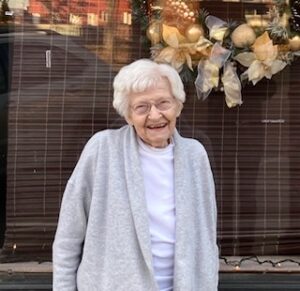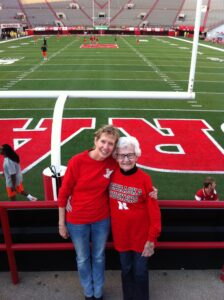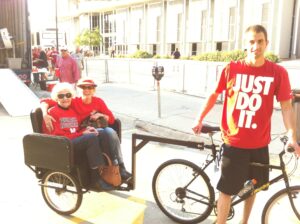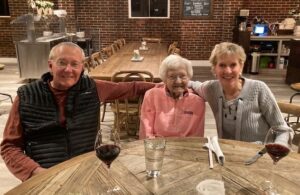Lila Tomek
Lila Tomek, 99, has been a Patient of Generations Family Dental for 50 Years
Lila Tomek has been a patient of Generations Family Dental since 1972. She and her family moved from Cozad, NE, to Humboldt (75 miles southeast of Lincoln) that summer. At the recommendation of a friend, she started seeing Dr. Don Asbjornson in Lincoln.
 Lila attributes her long life to good genes and many hobbies and interests. Back in the day she loved to garden, sew, crochet, knit, and paint china. Lila still enjoys cooking, baking, and studying recipes.
Lila attributes her long life to good genes and many hobbies and interests. Back in the day she loved to garden, sew, crochet, knit, and paint china. Lila still enjoys cooking, baking, and studying recipes.
It turns out Dr. Jon (son of Dr. Don) shares an interest in history with Lila and has spent time visiting with her about a unique World War II experience. He even got her autograph on the print that’s hanging in the hall of the dental office.
During World War II, when she was only 19, she left her office job in Pawnee City, NE, to apply for work at the Glenn L. Martin Bomber Plant near Omaha. It was the fall of 1942, and her two younger brothers had been drafted to serve in the Army. Although she wanted to serve in the Army as well, her brothers shot down the idea immediately! So instead, she decided to serve the war effort by joining many others in assembling two bomber planes: the B-26 Marauder and the B-29 Superfortress.
When Lila started, the workforce was primarily male; however, as the men were drafted into the military, Martin realized there wouldn’t be enough males on the factory floor. He explained to the many doubters that women were perfectly suited to handle the 25,000 parts that comprised a B-26 and the miles of wiring that needed to be snaked through harnesses along with other work in close quarters.
After being hired October 3, 1942, for $0.60 an hour she was sent to a four-week sheet metal and blue print training course at Tech High School in Omaha. Once the training was completed, she ran a rivet gun, spliced cables, worked in final assembly, and participated in a special assignment.
 One day, she and her riveting partner, Rosie from Verdigre, NE, along with a few other men were told to report to the main gate where they were transported to a separate Army hanger that housed five planes. The assignment required them to work seven days a week, 12-14 hours a day until the work was completed. They were told the project was top secret and instructed to tell no one about it. Lila wondered why they were removing the armor plate and the ammunition racks from the planes.
One day, she and her riveting partner, Rosie from Verdigre, NE, along with a few other men were told to report to the main gate where they were transported to a separate Army hanger that housed five planes. The assignment required them to work seven days a week, 12-14 hours a day until the work was completed. They were told the project was top secret and instructed to tell no one about it. Lila wondered why they were removing the armor plate and the ammunition racks from the planes.
One day as they were working, the whistles blew, and the loudspeaker instructed everyone to descend from their ladders and face east. Imagine their huge surprise when the doors opened and a convertible carrying President Franklin D. Roosevelt and two others entered, and the President saluted the workers at each plane.
On August 6, 1945, when the Omaha-built Enola Gay dropped the first atomic bomb on Hiroshima, Japan, the group was called into a meeting to learn the significance of their special assignment. Stripping the planes of armor plate and ammunition racks made them light enough to carry the heavy bomb and extra fuel required for the mission.
Lila’s employment concluded August 21, 1945, as the military contracts were being terminated.
By Nancy Tomek Wilcher (her daughter)




